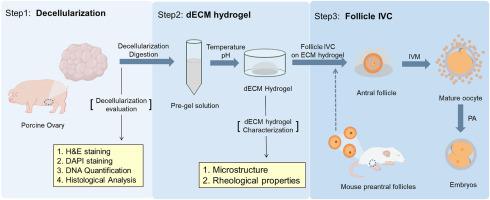本研究旨在利用脱细胞技术,从采用猪支架的仿生卵巢中培养的小鼠腔前卵泡中获取成熟卵母细胞。我们评估了脱细胞 (decell) 猪卵巢中的 DNA 含量以及细胞和细胞外基质 (ECM) 成分的存在,包括胶原蛋白、弹性蛋白和糖胺聚糖 (GAG)。decell 卵巢组织中的 DNA 含量比天然组织中的 DNA 含量大约低 94%(66 ± 9.8 ng/mg vs. 1139 ± 269 ng/mg)。此外,脱细胞卵巢组织中 ECM 成分的完整性得以保持。天然卵巢组织(天然)的可溶性胶原浓度为 195.34 ± 15.13 μg/mg(干重),由于细胞质量的损失,低于去细胞卵巢组织的 878.6 ± 8.24 μg/mg。制备源自 decell 猪卵巢的水凝胶,以开发具有适当 ECM 浓度(2−6 mg/mL)的体外仿生卵巢。扫描电子显微镜(SEM)成像显示,在不同 ECM 浓度(2-6 mg/mL)处理的所有组中均保持了复杂的纤维网络和多孔结构。此外,流变仪分析表明机械强度随 ECM 浓度的增加呈剂量依赖性。用 4 mg/mL ECM 培养的窦前卵泡显示出较高的窦卵泡 (66%) 和成熟卵母细胞(中期 II)发育率 (47%)。在具有 decell 猪支架的仿生卵巢中培养的窦前卵泡显示出比在胶原蛋白和基质胶等其他生物材料中培养的窦前卵泡和成熟卵母细胞更高的比率。在源自窦卵泡的成熟卵母细胞中,分别使用微管蛋白抗体和 Hoechst 对减数分裂纺锤体和细胞核进行染色。双细胞胚胎是在孤雌生殖激活后由 MII 卵母细胞发育而来。在源自脱细胞猪卵巢 ECM 的仿生卵巢中培养腔前卵泡,并从 MII 卵母细胞产生胚胎。这种仿生卵巢可能有助于恢复卵巢功能下降的不孕女性的生育能力,有利于濒危物种的交配工作,并维持具有宝贵遗传特征的动物。
 "点击查看英文标题和摘要"
"点击查看英文标题和摘要"
Control of the growth and development of murine preantral follicles in a biomimetic ovary using a decellularized porcine scaffold
This study aimed to derive mature oocytes from murine preantral follicles cultured in a biomimetic ovary with a porcine scaffold using decellularization technology. We evaluated the DNA content and the presence of cell and extracellular matrix (ECM) components, including collagen, elastin, and glycosaminoglycans (GAGs), in decellularized (decell) porcine ovaries. The DNA content inthe decell ovarian tissues was approximately 94 % less than that in native tissues (66 ± 9.8 ng/mg vs. 1139 ± 269 ng/mg). Furthermore, the ECM component integrity was maintained in the decell ovarian tissue. The soluble collagen concentration of native ovarian tissue (native) was 195.34 ± 15.13 μg/mg (dry wt.), which was less than 878.6 ± 8.24 μg/mg for the decell ovarian tissue due to the loss of cellular mass. Hydrogels derived from decell porcine ovaries were prepared to develop an in vitro biomimetic ovary with appropriate ECM concentration (2−6 mg/mL). Scanning electron microscope (SEM) imagining revealed that the complex fiber network and porous structure were maintained in all groups treated with varying ECM concentration (2–6 mg/mL). Furthermore, rheometer analysis indicated that mechanical strength increased with ECM concentration in a dose-dependently. The preantral follicles cultured with 4 mg/mL ECM showed high rates of antral follicle (66 %) and mature oocyte (metaphase II) development (47 %). The preantral follicles cultured in a biomimetic ovary with a decell porcine scaffold showed a higher rate of antral follicle and mature oocytes than those cultured in other biomaterials such as collagen and Matrigel. In mature oocytes derived from antral follicles, meiotic spindles and nuclei were stained using a tubulin antibody and Hoechst, respectively. Two-cell embryos were developed from MII oocytes following parthenogenetic activation. Preantral follicles were cultured in a biomimetic ovary derived from the ECM of a decell porcine ovary, and embryos were generated from MII oocytes. This biomimetic ovary could contribute to restoring fertility in infertile women with reduced ovarian function, benefit mating efforts for endangered species, and maintain animals with valuable genetic traits.




















































 京公网安备 11010802027423号
京公网安备 11010802027423号